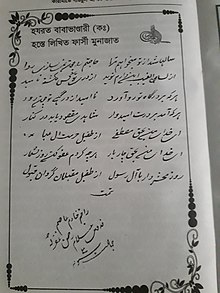Gulamur Rahman
This article has multiple issues. Please help improve it or discuss these issues on the talk page. (Learn how and when to remove these messages)
|
Gulamur Rahman Maizbhandari | |
|---|---|
| Personal life | |
| Born | Syed Gulamur Rahman 1865 |
| Died | 1937 (aged 71–72) Maizbhandar, Bengal Presidency, British India |
| Resting place | Shrine of Syed Gulamur Rahman Maizbhandari, Maizbhandar, Bangladesh |
| Children | Syed Khairul Bashar Maizvandari Syed Abul Bashar MaizbhandariMaizvandari Syed Mahbubul Bashar Maizvandari Alhaz Syed Safiul Bashar Maizvandari Syeda Maimuna Khatun Maizvandari Syeda Sazeda Khatun Maizvandari |
| Known for | 2nd leader of the Maizbhandari Sufi Order |
| Relatives | Syed Ahmad Ullah (uncle) Ziaul Haq (grandson) |
| Religious life | |
| Religion | Islam |
| Denomination | Sunni |
| Jurisprudence | Hanafi |
| Tariqa | Maizbhandari |
| Part of a series on Islam Sufism |
|---|
 |
|
|
Gulamur Rahman Maizbhandari (Bengali: গোলামুর রহমান মাইজভাণ্ডারী; 1865–1937), also known by his sobriquet Baba Bhandari (Bengali: বাবা ভাণ্ডারী), was a Bengali Sufi preacher who succeeded his uncle, Syed Ahmad Ullah, as the head of the Maizbhandari Sufi Order, the first such Sufi order in Bengal.[1]
Background and ancestry
[edit]This section needs additional citations for verification. (April 2016) |
Gulamur Rahman's father was Abdul Karim Shah, younger brother of Syed Ahmad Ullah, and his mother was Musharaf Jaan. His paternal ancestors were Syeds and originally migrated from Madinah to Gaur, the former capital of medieval Bengal, via Baghdad and Delhi. His ancestor, Hamid ad-Din, was the appointed Imam and Qadi of Gaur, but due to a sudden epidemic in the city, Hamid later migrated to Patiya in Chittagong District.[2] Hamid's son, Syed Abdul Qadir, was made the imam of Azimnagar in modern-day Fatikchhari. He had two sons; Syed Ataullah and Syed Tayyab Ullah. The latter had three sons; Syed Ahmad, Syed Matiullah and Syed Abdul Karim, and the youngest son was the father of Gulamur Rahman.
Early life and education
[edit]Rahman was born into a Bengali Muslim family in the village of Maizbhandar in Fatikchhari, Chittagong on 14 October 1865. His uncle, who called him "the rose of my garden", entrusted him with the teaching of students, particularly adepts.[3] He spent time wandering alone in the woods as part of his spiritual studies.[1] Around 1914, he entered a state of meditation and stopped speaking except on rare occasions, thus becoming known as a magdub pir. In 1928, he moved out of his father's house into his own, where disciples and his four sons took over responsibility for the order's administration.[1]
Succession from Syed Ahmad Ullah
[edit]According to German scholar Hans Harder, there is disagreement over the type of spiritual mandate Gholam Rahman received from Syed Ahmad Ullah and his status as a saint. Writers from Rahmaniyya Manzil, the house of the descendants of Gholam Rahman, class him as a ġawṯ al-aʿẓam, the highest category of walī Allāh, alongside Ahmadullah, and sometimes claim that he was installed by Ahmadullah as his spiritual successor (sağğādanašīn). The descendants of Syed Ahmad Ullah, however, insist that he was Ahmadullah's main delegate (pradhān khaliphā), and object to him receiving the title of ġawṯ al-aʿẓam, though it does appear in one of Delawar Hosain's writings.[1]

See also
[edit]References
[edit]- ^ a b c d Harder, Hans (4 March 2011), Sufism and Saint Veneration in Contemporary Bangladesh: The Maijbhandaris of Chittagong, Routledge (published 2011), pp. 25, 26, ISBN 978-1-136-83189-8
- ^ Harder, Hans (2011), Sufism and Saint Veneration in Contemporary Bangladesh: The Maijbhandaris of Chittagong, Routledge, pp. 15–22, ISBN 978-1-136-83189-8
- ^ Bertocci, Peter J. (February 2006). "A Sufi movement in Bangladesh: The Maijbhandari Tariqa and its Followers". Contributions to Indian Sociology. 40 (1): 9. doi:10.1177/006996670504000101. S2CID 144167466.
External links
[edit]- Bertocci, Peter J. (February 2006). "A Sufi movement in Bangladesh: The Maijbhandari Tariqa and its Followers". Contributions to Indian Sociology. 40 (1): 1–28. doi:10.1177/006996670504000101. S2CID 144167466.
